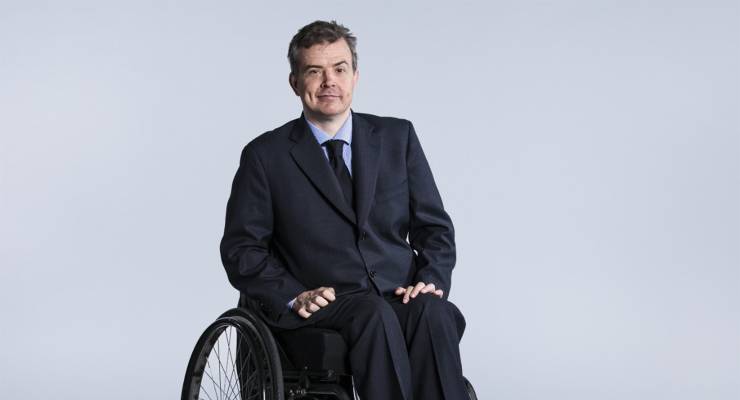
The cost of the National Disability Insurance Scheme (NDIS) is nearly three times higher than original 2011 estimates, costing Australia $35 billion this year alone as Prime Minister Anthony Albanese flags a crackdown on spending.
But conversations about increasing costs rarely seem to involve the NDIS’ return on investment, and how supporting people with disabilities to live independently, hold gainful employment and lead fuller lives contributes to the economy — and society.
On ABC RN’s Breakfast this morning, disability discrimination commissioner Ben Gauntlett warned experts and politicians shouldn’t “lose sight of the humanity that underpins” the scheme. He said without the scheme, he likely wouldn’t be living in his family home with his partner, and might not have been able to have the child they’re expecting in December.
“I probably would still be living with my parents … with my mum leaving me microwavable meals,” he said.
“We can never lose sight of the humanity that underpins the NDIS.”
What is this ‘cost blowout’?
Since the NDIS’ inception, there have been grave warnings of a cost blowout. Original 2011 estimates found the NDIS would cover 411,000 participants and cost $13.6 billion per year.
These figures were updated in 2012 and found that the NDIS at full operation would cost $22 billion a year or $50,000 per person across 441,000 participants by 2019.
They’ve been updated again still in the recent budget, estimating this year the scheme will cost $35 billion covering 535,000 participants. Budget forecasts estimated the scheme could cost $52 billion per year within the next four years, and $100 billion a year by the end of the decade, making it the most expensive government social program.
Revised forecasts are due to a number of beneficial reasons, including more people accessing the scheme, namely those with psychosocial disabilities due to earlier diagnosis and better understanding, and fewer people exiting the scheme at the anticipated rate because they’re living longer.
What these forecasts also fail to consider is the impact the NDIS has on the economy.
What is the return on investment?
A Per Capita report released in November last year found that the economic impact of the NDIS is larger than any other type of government spending. A conservative estimate was that the multiplier effect of the NDIS would be around 2.25 — meaning its economic contribution from 2020 to 2021 was $52.4 billion.
If the NDIS costs $35 billion this year, that means $78.7 billion will be injected into the economy.
One major reason for this is the number of people the scheme employs. The report estimates that the NDIS directly employs more than 270,000 people across 20 different occupations, from local area coordinators to planners, and indirectly employs tens of thousands more, from support workers to physiotherapists.
For every $1 billion the NDIS is underfunded, Per Capita researchers estimated there’d be a drop in the national employment rate by 0.1% with a loss of 10,200 jobs and a decline in total economic activity of $2.25 billion — reducing the GDP by 0.14%.
Disability scholar Trevor Parmenter tells Crikey employment is one of the key contributors of the NDIS to the economy — but that employment rates were not where they should be. People with disabilities are twice as likely to be unemployed than those without disabilities, with 10% not working. That percentage creeps to 25% for those aged 15 to 24.
But it’s more than just jobs, he said: “The packages also lead to better health outcomes. Health is not part of the NDIS, but getting enough support certainly lifts general well-being, which includes health.” This could see a decrease in Medicare costs.
“When we make economic statements we should also be including impacts on the nation’s wellbeing,” he said.
Where’s the support?
Most Australians support a fully funded NDIS. According to last year’s Australia Talks National Survey, 82% of people thought the government should spend as much as is necessary to ensure people with disabilities have the same opportunities as everyone else.
There are issues around how much money people get: NDIS participants from higher socioeconomic backgrounds tend to get more funding, likely due to their ability to navigate the scheme and advocate for themselves. Parmenter said successive governments likely hadn’t properly considered how many people with psychosocial disabilities would also be eligible for the scheme.
But the government needed to do better at understanding the benefits of the NDIS. “We don’t tend to measure what better means … we need to go much deeper into how their lives are being impacted,” he said.
This also means cracking down on providers that underdeliver. The October budget included $126 million over four years for a “fraud fusion taskforce” to crack down on fraud and non-compliance by provider companies.
Gauntlett has also called for better data collection on the outcomes of services NDIS participants were paying for via the national disability data asset.
“It’s not enough to look at a policy and say this is the cost, let’s look at the benefit,” he said.








Our collective humanity has always been there – all the organisations which filled the care segment of our society . Now they have gone so has collective humanity – replaced by a government organisation with no humanity just processes- based upon flawed premises throwing the taxpayers money away .
There is no doubt that there is a lot of overservicing as well as the usual rorting in the system. Means testing may be an option too, a lot of money floating around for some.
However, I wonder if there may or should be a continuum of sorts between ndis and the disability pension. The previous govt was so fixated on stopping deserving people from receiving the disability pension that maybe meant that they became eligible for the ndis instead if it was easier to access.
Thanks Amber, good article.
Another thing not considered when we talk about the costs of the NDIS are all the savings from the services no longer offered because the NDIS is seen as replacing them. This includes services for people with mental illnesses and their family carers.
yes – in fact logically no one should donate to any health charities, as the government has taken Over their role – in fact you cannot even be charity unless you fill out lots of paperwork and government approves. NDIS
has replaced the organised services to the disabled these services have evolved for over hundred years.
Good work Amber. About time someone spoke up about the return on investment. Turns out when you be nice to fellow humans there is a positive result. Unfortunately the “small government” screeching neo-libs will never acknowledge it. They only want to fixate on the upfront cost. Its a continuous battle.
hear hear!